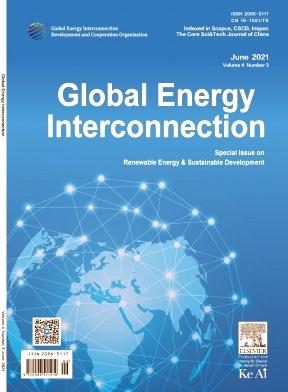基于健身-距离-平衡的白鲸优化PV-TEG混合系统的最佳功率提取
IF 1.9
Q4 ENERGY & FUELS
引用次数: 0
摘要
本研究将单独的光伏(PV)和热电发电机(TEG)系统整合为一个PV-TEG混合系统,通过再利用光伏发电过程中产生的余热来提高其整体功率输出,以提高其运行可靠性。然而,随机环境条件通常会导致PV-TEG模块的部分遮阳条件和不均匀的热分布,这对系统的输出特性产生负面影响,从而对保持其最佳性能提出了重大挑战。为了解决这些问题,研究人员设计了一种基于适应度-距离平衡的新型白鲸优化(FDBBWO)策略,以最大化PV-TEG混合动力系统在动态运行场景下的功率输出。在个案研究中考虑了更广泛的复杂和真实的业务情况,以审查FDBBWO的有效性和可行性。为此,我们使用了在香港不同季节收集的真实数据集来验证建议策略的实际可行性。仿真结果表明,基于FDBBWO的最大功率点跟踪技术在功率波动最小的情况下实现了最高的能量输出,显著提高了134.25%。在冬季,FDBBWO法比BWO法、摄动法和观测法获得的能量分别高出47.45%和58.34%。本文章由计算机程序翻译,如有差异,请以英文原文为准。
Optimal power extraction of PV-TEG hybrid system via fitness-distance-balance-based beluga whale optimization
This study integrates the individual photovoltaic (PV) and thermoelectric generator (TEG) systems into a PV-TEG hybrid system to improve its overall power output by reutilizing the waste heat generated during PV power production to enhance its operational reliability. However, stochastic environmental conditions often result in partial shading conditions and nonuniform thermal distribution across the PV-TEG modules, which negatively affect the output characteristics of the system, thus presenting a significant challenge to maintaining their optimal performance. To address these challenges, a novel fitness-distance-balance-based beluga whale optimization (FDBBWO) strategy has been devised for maximizing the power output of the PV-TEG hybrid system under dynamic operation scenarios. A broader spectrum of complex and authentic operational contexts has been considered in case studies to examine the effectiveness and feasibility of FDBBWO. For this, real-world datasets collected from different seasons in Hong Kong have been used to validate the practical viability of the proposed strategy. Simulation results reveal that the FDBBWO based maximum power point tracking technique outperforms its competing methods by achieving the highest energy output, with a remarkable increase of up to 134.25 % with minimal power fluctuations. For instance, the energy obtained by FDBBWO is 47.45 % and 58.34 % higher than BWO and perturb and observe methods, respectively, in the winter season.
求助全文
通过发布文献求助,成功后即可免费获取论文全文。
去求助
来源期刊

Global Energy Interconnection
Engineering-Automotive Engineering
CiteScore
5.70
自引率
0.00%
发文量
985
审稿时长
15 weeks
 求助内容:
求助内容: 应助结果提醒方式:
应助结果提醒方式:


